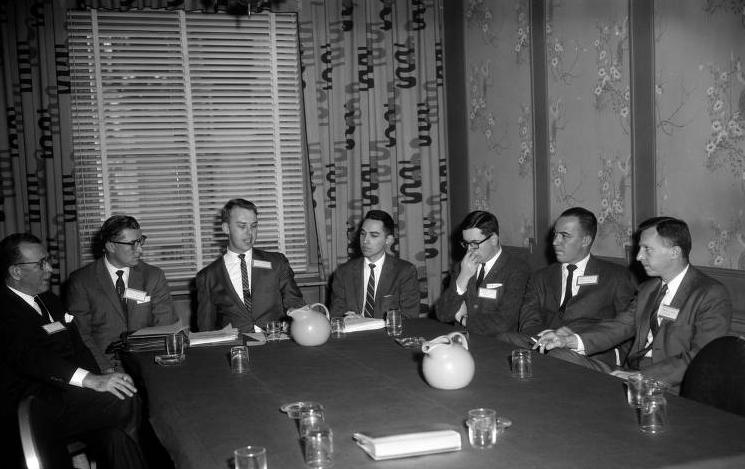The first bar association was formed in Indianapolis in the early 1870s but was unsuccessful. Forty prominent lawyers founded the Indianapolis Bar Association (IndyBar) on November 30, 1878, at the law offices of Dye & Harris. Among the members were future U.S. presidents and , U.S. vice president under President Theodore Roosevelt. Napoleon B. Taylor served as the first president and John M. Judah as the organization’s treasurer. At the time of its founding, the Association charged a $20 annual membership fee, which was reduced to $5 in 1879 after numerous complaints.

The Association organized to provide a common space where lawyers could meet to achieve its objectives to serve its members, maintain professional standards and practices within the legal profession, and provide law-related community service. Its constitution originally established five standing committees.
The Association’s first priority was to establish a law library and reading room for judges, attorneys, and students of the Indiana Law School. In 1880, a librarian was hired earning $3 per week. By 1910, over 7,000 volumes filled the library. The association also has always hosted annual social events and monthly meetings that include dinner and presentations on a legal, historical, civic, or social topic.
The 40 founding members grew to nearly 300 by the 1920s. The IBA admitted its first African American member Robert L. Bailey in the 1920s. Women were admitted in the 1930s. For several decades, the number of African American women members remained small, and African American attorneys established their own organization, the , to serve their needs. Originally, the Indianapolis Bar gathered at the Marion County Courthouse or a local club.
The Bar Association has continually served the legal profession through committees that monitor the professional conduct of the bench and bar as well as investigate and recommend improvements in the system of justice in Marion County. Indianapolis also has benefited from its volunteer legal services, early provided services to indigent clients and in 1941 sponsored the creation of the Indianapolis Legal Aid Society. During World War I and World War II, it maintained the practices of members in the armed services.
Even after it bought a clubhouse at Meridian and Ohio streets in 1933, the organization continued to gather at the Marion County Courthouse or at local clubs. It found a permanent location when it moved into the Loew’s Theater building (33 North Pennsylvania) in 1955. The Indianapolis Bar remained at Loew’s until 1970 when it moved into offices, which included a club dining facility at the .
IndyBar hired its first executive, Rosalie F. Felton, in 1972. During Felton’s tenure, African Americans and women joined in greater numbers. It also chose to take on a more active educational and community role. As its membership and the complexity of the practice of law increased in the 1970s, the organization expanded continuing education opportunities and organized sections specializing in various fields of law. In 1980, it also became the first bar association in the nation to provide extensive pro bono services using only volunteer resources. Mary Y. Marsh became the first woman to become president of the organization in 1988, and in 1989, the Association relocated to Market Tower (10 West Market Street), with a membership of more than 1,000 members.
By the early 1990s, IndyBar had increased the number of its standing committees to 29. Through committee intervention, it has worked to increase judges’ salaries, recodify municipal law, recommend judicial appointments, monitor standards for legal education and acceptance to the bar, investigate racketeering, and improve various court systems and procedures. During the 1990s, community and pro bono programs included legal counseling, school programs, career talks, and a public grievance committee. By 1999, the association again relocated to 107 North Pennsylvania as its growing member activities required more space as the numbers had swelled to nearly 5,000. At its peak in the early 2000s, it boasted more than 5,600 members.
In 2001, IndyBar became the only bar association in the country offering semi-annual courses to prepare law students for the bar examination. The first African American elected president was the Honorable Cynthia J. Ayers of the Marion Superior Court, who served in 2006.
The 2008 recession led to a reduction in the population of attorneys that affected IndyBar membership roster numbers. Despite this reduction in membership, the hundreds of courses that the association produced led to a move to 135 North Pennsylvania in 2009.
In 2020, there were 4,536 members. Along with its large education offerings, member services include a lawyer referral service, law practice management tools, networking programs, and informational publications. With the desire to offer more space for the changing needs of its members, IndyBar moved to 140 North Illinois in early 2020, opening offices only days before the COVID-19 pandemic brought the close of usual operations.

Help improve this entry
Contribute information, offer corrections, suggest images.
You can also recommend new entries related to this topic.